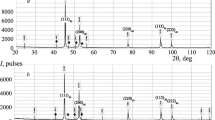Conclusions
-
1.
During the entire process of the cooling of cylindrical specimens in aqueous polymeric solutions (for example, PAA), there is a large temperature gradient along their vertical axis. This nonisothermal character is governed by the coexistence of different heat-exchange regimes in separate intervals of the cooling process. When an alloy D16 specimen 20 mm in diameter and 80 mm long is cooled for a period of approximately half its total cooling period, for example, approximately 90% of its surface is found in a film boiling regime. The second half of the cooling period is characterized by combined heat emission, which can be accomplished in accordance with three regimes; film, effervescent, and convective. In this case, the surface area encompassed by the film-boiling regime is reduced, and the effervescent regime progresses and is then, in turn, “supplanted” by the convective regime.
-
2.
To determine the cooling capacity, or heat emission under nonstationary conditions, it is recommended to use long and thin specimens with a central thermocouple with the leads run through an axial channel.
-
3.
The method of determining the cooling capacity of quenching media using surface thermocouples with their leads run through the medium should be eliminated from practice.
-
4.
In calculating the temperature fields in real components, it is necessary to bear in mind the possible nonuniformity of boundary and initial conditions governing the existence of wave phenomena. The wave of an effervescent-boiling regime may come, for example, from the base of such structural elements as stiffeners, pins, etc.
Similar content being viewed by others
Literature cited
N. I. Kobasko, Quenching of Steel in Liquid Media Under Pressure [in Russian], Naukova Dumka, Kiev (1980), p. 208.
V. I. Fedorov and N. P. Timchenko, “On wave phenomena during quenching in liquid media”, Theses of Papers: Experience with the Development and Industrial Implementation of Incombustible Quenching Media and Methods Used to Monitor Their Cooling Capacity [in Russian], Vsesoyuznyi Nauchno-Issledovatel'skii i Éksperimental'no-konstruktorskii Institut Torgovogo Mashinostroeniya, Volgograd (1982), pp. 37–40.
G. M. Kondrat'ev, Regulated Heat Regime [in Russian], GITTL, Moscow (1954).
V. I. Tolubinskii, heat Exchange during Boiling [in Russian], Nauka Dumka, Kiev (1980).
Additional information
Institute of Technical Thermophysics, Academy of Sciences of the Ukrainian SSSR. Translated from Metallovedenie i Termicheskaya Obrabotka Metallov, No. 10, pp. 25–29, October, 1986.
Rights and permissions
About this article
Cite this article
Kobasko, N.I., Timchenko, N.P. Cinematographic investigation of the cooling process of alloys in aqueous polymeric solutions. Met Sci Heat Treat 28, 729–734 (1986). https://doi.org/10.1007/BF00741859
Issue Date:
DOI: https://doi.org/10.1007/BF00741859




